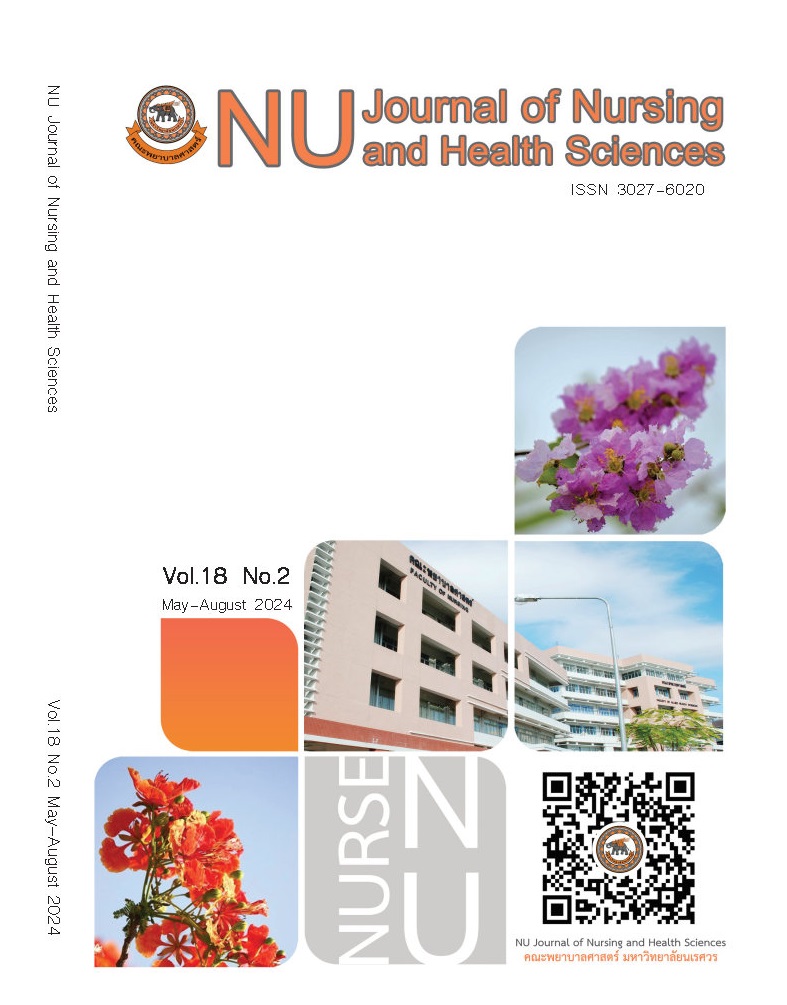Effects of Music Embedded with Binaural and Superimposed Beats on the Pain Reduction of Patients in the Emergency Department
Main Article Content
Abstract
This study is a quasi-experimental research. The purpose was to study effects of music embedded with binaural and superimposed beats on the pain reduction of 70 patients in the emergency department, aged 20-81 years old, divided into a control group and an experimental group, each group of 35 people. The control group received nursing care to reduce pain as usual. The experimental group received a combination of music embedded with binaural and superimposed beats 1 time, 30 minutes each time along with normal treatment. The instrument used for assessing included personal information questionnaires, the pain score, the satisfaction assessment form for the use of the music set and the music embedded with binaural and superimposed beats 1 set. Data were analyzed using percentage, mean, standard deviation, Chi-square test, Fisher's exact test statistics, Wilcoxon signed rank test and Mann-Whitney U test. The results showed that 1) The experimental group after using the music embedded with binaural and superimposed beats had significantly lower pain scores than before using music therapy. (p<.01) and 2) the intervention group receiving the music embedded with binaural and superimposed beats had significantly lower pain scores than the control group (p<.01). The satisfaction scores for using the music set were rated highly ( = 4.59, S.D.= 0.47). Therefore, the use of the music embedded with binaural and superimposed beats can be used in addition to the normal nursing care for reduce pain and increase comfort in patients in emergency department.
Article Details

This work is licensed under a Creative Commons Attribution-NonCommercial-NoDerivatives 4.0 International License.
References
American Music Therapy Association. (2022). What is music therapy?. Retieved 22 October 2022
from http://www.musictherapy.org
Bangrakam Hospital. (2022). Annual report information Bangrakam Hospital Bang Rakam District. Phitsanulok Province: Bangrakam Hospital. [In Thai].
Chinn, P. L., & Kramer, M.K. (2015). Knowledge development in nursing: Theory and process. St. Louis, Missouri: Elsevier.
Chotpanang, A., Pattrapakdikul, U., (2016). The effects of listening to favorite music on pain and vital signs in gynecologic patients after abdominal surgery. Nursing Journal of The Ministry of Public Health, 26(2), 43-53. [In Thai].
Ghori, M. K., Zhang, Y. F., & Sinatra, R. S. (2009). Pathophysiology of acute pain. Acute Pain Management (pp. 21–32). UK: Cambridge University Press. DOI:10.1017/CBO9780511576706.003
Horgas, A. L., Yoon, S. L., & Grall, M. (2008). Pain management. Evidence-based geriatric nursing protocols for best practice (4th ed., pp. 246-267). New York, USA: Springer Publishing Company.
Im-erb, P., Kongchoom, W., Rimsueb, K. (2014). The effects of music therapy on post-operative pain. Nursing Journal of The Ministry of Public Health, 23(3), 53-62. [In Thai].
Indratula, R., Lertwatthanawilat, W., Promphuk, B., Kardosod, A., & Womgcharoen, W. (2020). Predicting factors of self-management among persons with chronic back pain. Nursing Journal, 47(4). 470-482. [In Thai].
Intarakaew, C. (2022). Music therapy and ritual sounds as deep healing music. Journal of Fine and Applied Arts Khon Kaen University, 14(2), 300-318. [In Thai].
Kraus, K. S., & Canlon, B. (2012). Neuronal connectivity and interactions between the auditory and limbic systems: Effects of noise and tinnitus. Hearing research, 288(1-2), 34-46.
Leaungsomnapa, Y., & Ngamkham, S. (2013). Attention to pain. The Journal of Prapokklao Hospital Clinical Medical Education Center, 30(1), 83-93. [In Thai].
Lemone, P., & Burke, K. M. (Eds.). (2004). Medical-surgical nursing: Critical thinking in client care (3rd ed). Upper Saddle River, NJ: Prentice Hall Health.
McGuire, D. B. (1984). The measurement of clinical pain. Nursing Research, 33(3), 152-156.
Melzack, R., & Wall, P. D. (1965). Pain Mechanisms: A new theory: A gate control system modulates sensory input from the skin before it evokes pain perception and response. Science, 150(3699), 971-979.
Na Wichian, S., Klaphajone , J., & Phrompayak, D. (2021). Effects of music embedded with binaural and superimposed beats controlling hypertension in older adults: A quasi experimental study. Pacific Rim International Journal of Nursing Research, 25(3), 345–358.
Nuchaiplot, P., Petpichetchian, W., & Sangchan, H. (2014). Development and evaluation of the emergency department traumatic wound pain management guidelines. Nursing Journal, 41(5), 88-98. [In Thai].
Salamon, E., Kim, M., Beaulieu, J., & Stefano, G. B. (2003). Sound therapy induced relaxation: Down regulating stress processes and pathologies. Medical Science Monitor, 9(5), RA96-RA101.
Seaward, B. L. (2017). Managing stress. Boston: Jones & Bartlett Learning.
Sripiboonbat, J., Khamhom, N., & Junnaruemit, K. (2020). The effect of nursing guidelines on pain reduction of abdominal pain patients in the accident and emergency department. Region 4-5 Medical Journal, 39(1), 79-88. [In Thai].
Teeraviroj, N., Kongnurut, A., Sookpadung, S., Kwangnork, S., Kittiwattanasarn, P. (2011). Postoperative pain assessment situation in orthopaedic patients, Buriram hospital. Journal of nurses’ association of Thailand, North-eastern division, 29(4), 33–39. [In Thai].
Wang, C. F., Sun, Y. L., & Zang, H. X. (2014). Music therapy improves sleep quality in acute and chronic sleep disorders: A meta-analysis of 10 randomized studies. International journal of nursing studies, 51(1), 51-62.


